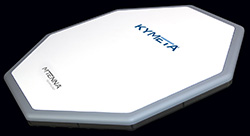
Our cover feature in the November 2016 issue, “Metamaterial Advances for Radar and Communications,” contained several errors about Kymeta’s metamaterial antenna. The following summary corrects these and clarifies Kymeta’s antenna technology:
The Kymeta antenna uses metamaterial resonators; however, they do not operate as phase shifters. Phase shifting is not required. Rather, the beam is formed by tuning some of the elements in the array while leaving others detuned. Using many elements at less than ë/2 spacing, an accurate hologram with cells at the right phase and amplitude can be achieved. The antenna resonators are considered metamaterials because they are sub-wavelength structures designed—not found in a natural material—for a specific and controlled electromagnetic response. The data rates supported by a system using a Kymeta antenna depend upon various factors, including antenna size and frequency.
While both Ku- and Ka-Band antennas have been demonstrated, Kymeta is presently commercializing a Ku-Band design. The antenna has completed successful demonstrations without incurring adjacent satellite interference; should interference occur, Kymeta can implement a feedback technique to reduce sidelobes.
In 2013, Kymeta worked with O3b Networks on an R&D project to develop an antenna; however, that effort did not lead to a contract to supply antennas for the O3b system. Kymeta has not disclosed the cost goal for the antenna. The antenna shown in Figure 2 was an early concept; a current photo of a Kymeta antenna is shown below.
Microwave Journal regrets these errors.
